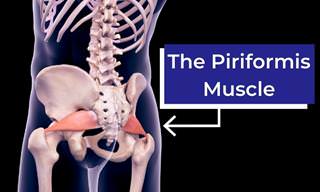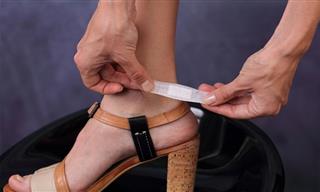Simple Stretches to Relieve Piriformis Pain
1. Cross-Body Piriformis Stretch
This cross-body stretch is super easy to do at home. It releases the piriformis muscles on each side, and it is perfect to alleviate tightness and pain in the buttocks and lower back. To complete this stretch, follow these steps:
1. Lie down on your back with both legs extended, preferably on a mat or a soft carpet.
2. Bend the left knee, and bring it up and towards the chest. Use both of your hands to keep the knee as close to the chest as you can without feeling any sharp pain.
3. Using your hands to guide the knew, move the left knee towards the right shoulder. In this position, it’s important to only move the legs and avoid lifting the left hip and the left side of the torso. Hold for 30 seconds; you should feel a stretch on the outside of your left buttock. Then release and straighten the left leg.
For a visual guide to this exercise, play the video above. Do this exercise 3 times in total, and then repeat on the opposite side.
2. Piriformis Figure 4 Stretch
The figure 4 stretch is one of the most widespread exercises for piriformis syndrome. Like the previous exercise, it doesn’t require any previous knowledge or preparation and is easy to do at home. To complete this exercise, follow this step-by-step guide and view the video above:
1. Lie down with the knees bent and the soles of the feet flat on the floor. Use a mat, towel, or carpet to cushion the shoulders, spine, and lower back.
2. Lift the left leg and place the left ankle on the right leg, slightly above the knee. Let the left knee open to the left so that the two legs together reminisce the number 4.
3. If your glute and piriformis are really tight, this may be enough for you to feel a stretch in the left buttock area. In that case, just stay in this position for 30 seconds. If you need a deeper stretch, place your hands behind the right thigh and use them to lift the right foot from the floor.
4. In this position, you can draw the legs closer and closer to the heart, until you feel a deep stretch in the left buttock area. Hold for 30 seconds and then release.
5. Repeat the stretch 3-4 times, and then let the right foot land back on the floor and let the legs unravel to the initial position. Switch sides.
3. Sitting Piriformis Stretch
If these previous exercises seemed too complex, and you’re looking for an exercise that will stretch the piriformis without you having to leave your work desk or lie down, this seated stretch is for you. This is the perfect exercise to do while you’re at work or in public. To complete the exercise, follow these steps and view the video guide above:
1. Sit in a chair with the legs shoulder-width apart.
2. Cross the left ankle over the right knee, allowing the left knee to open and relax, just like we did in the previous stretch. This position alone may already be quite challenging, and you could feel the stretch in the left side already. If so, stay in this position for 30 seconds.
To further deepen the stretch, start slowly leaning forward until you feel a significant but not painful stretch. In this position, it’s important to keep the spine straight as you lean forward with your torso. Avoid rounding the shoulders and the back, as this could worsen the pain. Hold for 30 seconds.
3. Repeat the stretch 3-4 times in total, and then repeat the same steps on the other side.
Share this article with family and friends!
 Go to BabaMail
Go to BabaMail
























